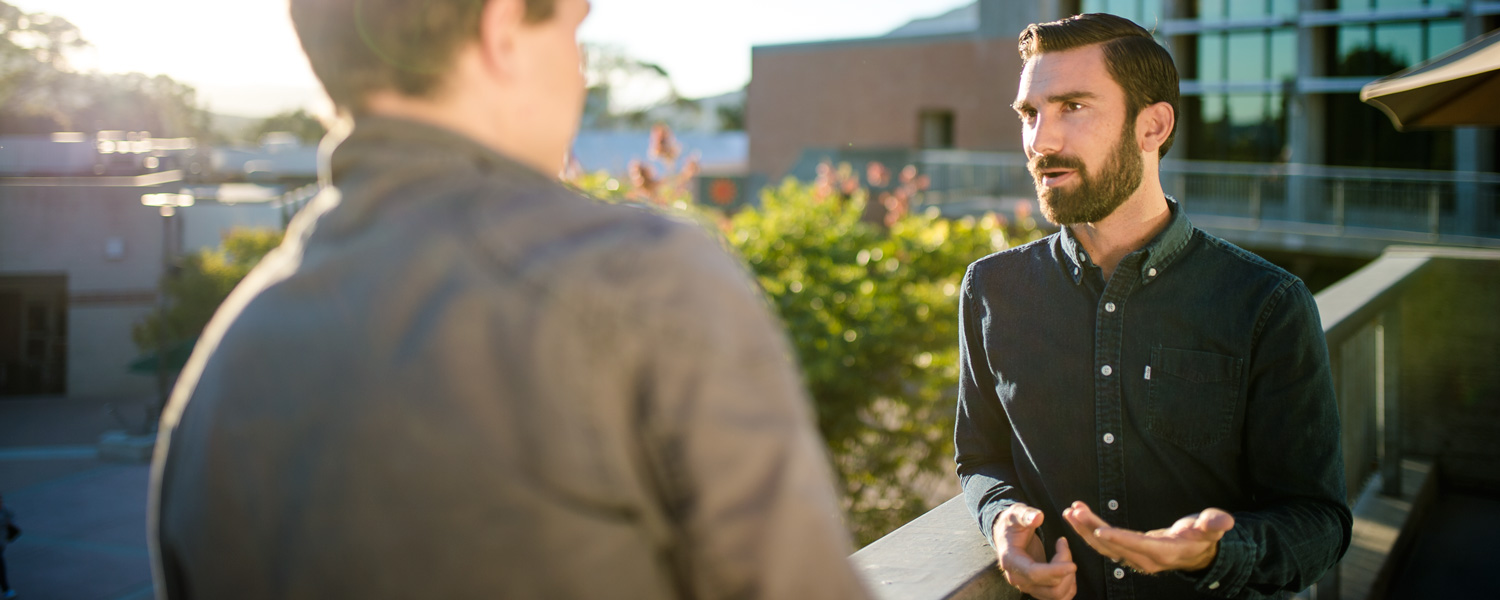cal poly news
Redefining Manhood
Interview by Larry Peña

A new program at Cal Poly is seeking to break ground on building healthier definitions of what it means to be a man. The new Men and Masculinity program, housed within Safer, the Student Affairs center dedicated to combatting gender-based violence, is the first of its kind in the California State University system. We spoke with the program’s first coordinator, Nick Bilich, about how men can affect positive change across a variety of gender-related issues.
Where did this new program come from?
This program came out of a couple of different ideas that Safer wanted to address. One was that sexual assault is statistically a very gendered violent act. If you look at national statistics, the vast majority of perpetrators are male — and that’s not just men perpetrating violence against women, but against people of all gender identities. There is a clear link between the way we are teaching boys to be men and this type of violence. So we realized that we need to invite more men to join the conversation about sexual assault prevention on campus, and the greater discussion of how we as men can live and advocate for positive expressions of masculinity.
When you focus on teaching people not to perpetrate sexual violence rather than teaching women to avoid it, what does that do to the conversation?
I think the educational focus on survivor behavior modification, traditionally this has been addressing what women need to do to avoid sexual assault, is pretty antiquated. I’ve counseled a lot of male students who have sexually assaulted someone — we use the term “respondent” — and oftentimes they say, “I had no intention of doing this, and would never, ever want to do this to someone.” And each respondent’s circumstances and decision making process is always intricate, and influenced by a number of cultural and societal factors. But one of my main goals as an educator is to help the respondent cultivate empathy and a greater understanding of human value—I think that understanding will lead to positive outcomes for respondents as they move forward. In the bigger picture, we are really trying to invest in our male students, not just for their four or five years at Cal Poly, but for a lifetime. So another part of our education is bringing men together to discuss what aspects of our cultural definition of masculinity lend themselves to even teeing people up to think or act in a way that might lead them to sexually assault someone, and what we can do about it.
Why do men need to take the lead on this?
It helps a lot when men see other men doing this kind of work — being good bystanders in the communities they’re involved in, modeling healthy relational and sexual activity, modeling consent well. When men are involved, I think it helps show us men that there are other narratives of masculinity that actually have amazing benefits to us individually, and to those around us.
So in practice, what does that training look like?
Right now the program is fairly rudimentary in some areas, and more developed in others. During fall quarter we’re conducting interviews with students, asking them about the culture of masculinity on campus, how it connects to sexual assault, what are some barriers to even starting these conversations, and what they would like to see from the program. The ultimate goal is to try to create places on campus where we can have these types of dialogues, and where people can cultivate positive masculinity. Let’s talk about what it means to be a man on campus. Let’s critically assess it — what’s good, what’s bad, and how can we move towards a healthier expression of masculinity, and hopefully invite other people into it. Apart from this, we also have a program called the sexual misconduct training, which is a six-week restorative program that we facilitate for respondents. We do this in partnership with our Title IX office and the Office of Student Rights and Responsibilities, who sanctions respondents to complete the training. We created the training with the intention of helping respondents process their actions, and hopefully gain helpful insight towards becoming more constructive participants in our student community. We also help facilitate a respondent advising program that trains faculty and staff to offer support to respondents during the Title IX investigation process. The investigation process can be really difficult for respondents, and we see support as critical to helping them confront the consequences of their actions in a healthy and restorative way.
We talked a lot about sexual assault issues, relationship violence issues — but what else is involved in this program?
We do this exercise with men all the time called the “man box” activity. We ask, “When you hear the prompt ‘act like a man,’ what comes to mind?” I’ve done this exercise with hundreds of people over the last four to five years, and everyone tends to have similar answers. Most people say it means you’re supposed to be strong, not show any emotion except for laughter or anger, heterosexual, either a player or monogamous with a really attractive female partner, making a lot of money, financially responsible, et cetera. But if you ask most people if they think this is their definition of masculinity, they say, “No that’s not my definition, but that’s what culture says.” So there is this tension between what we think masculinity is supposed to be culturally, and our own understanding. It’s been really interesting to hear the conversations surrounding this, because it tends to be really positive, especially for people who fall outside that traditional definition—gay men, trans men — actually most men don’t fit that definition. So I think it has been really good to acknowledge men whose identities we need to bring into the conversation.





